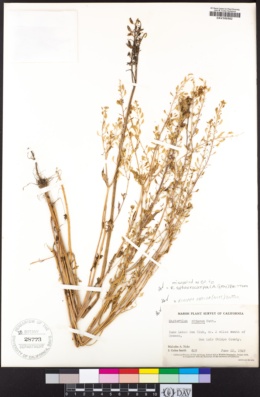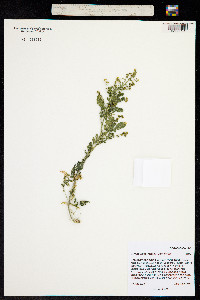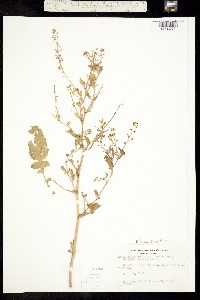Rorippa sphaerocarpa
|
|
|
|
Family: Brassicaceae
Round-Fruit Yellowcress, more...roundfruit yellowcress
[Nasturtium sphaerocarpum A. Gray, moreRadicula sphaerocarpa (A. Gray) Greene] |
Annuals or, rarely, biennials; (terrestrial or of wet habitat, not submerged); glabrous or hirsute. Stems (simple or few- to many-branched from base), decumbent or erect, branched distally, 1-4(-5.5) dm, (hirsute proximally). Basal leaves rosulate; blade margins pinnatifid. Cauline leaves shortly petiolate or sessile; blade oblong to oblanceolate, (lateral lobes oblong to ovate), (3.5-) 4.5-9(-12) cm × 10-25(-33) mm, (lateral lobes smaller than terminal), base auriculate or not, margins pinnatifid to pinnatisect, or (lateral lobes) crenate to subentire. Racemes elongated. Fruiting pedicels divaricate to slightly reflexed, straight or recurved, 1.5-3.7(-4.3) mm. Flowers: sepals ascending, oblong to ovate, 0.7-1.3 × 0.4-0.7 mm; petals yellow, oblanceolate to spatulate, 0.6-1.2 × 0.2-0.5 mm; median filaments 0.9-1.2 mm; anthers ovate, 0.2-0.3 mm. Fruits silicles, straight, globose or subglobose, 1.2-2.5(-3) mm diam.; valves glabrous; ovules 20-42 per ovary; style 0.1-0.7(-1) mm. Seeds biseriate, brown, cordiform, 0.5-0.7 mm, finely colliculate. Flowering May-Aug. Shores of ponds and lakes, mud flats, stream edges, moist grounds; 1200-3300 m; Ariz., Calif., Colo., Idaho, N.Mex., Tex., Utah, Wyo.; Mexico (Chihuahua). Annual herb with a taproot Leaves: alternate, pinnately divided. Flowers: in branched clusters (racemes). Sepals four, ascending. Petals four, yellow, less than 3 mm long. Fruit: a round to widely oblong pod. Similar species: No information at this time. Habitat and ecology: This species is typically found in moist areas west of the Mississippi River. It is rare in the Chicago Region. Occurence in the Chicago region: non-native Etymology: Rorippa possibly comes from the Latin roro, meaning "to be moist," and ripa, meaning riverbank. Sphaerocarpa means "rounded fruit." Author: The Morton Arboretum General: Annual or biennial, 10-40 cm tall; stems solitary or few to many, decumbent to erect, sometimes rooting wherever the stems come in contact with the ground; herbage glabrous or sparsely hirsute at the base; taprooted. Leaves: Basal (withered by flowering) and cauline, oblanceolate to oblong, 4-10 cm long, 1.3-3.2 cm wide, deeply pinnatifid, the upper cauline blades reduced and less deeply divided, margins of the lobes crenate to irregularly serrate or entire and lower cauline blades petiolate, upper cauline blades sometimes sessile. Flowers: Inflorescence of terminal and axillary racemes, often elongating in fruit; pedicels slender, widely spreading- ascending, 3.5-10.5 mm long; sepals 2-3 mm long, enlarged at the base, falling early; petals spatulate, 2.5-3.7 mm long, yellow; flowers June-August. Fruits: Silicle, globose to ovoid, 1.5-2.5 mm long, round in cross-section; seeds approximately 10-20 per fruit. Ecology: Streambanks, pond and lake margins, muddy habitats; 1500- 2400 m (5000-8000 ft); Apache, Coconino, and Pima counties; southwestern U.S., northern Mexico. Notes: Rorippa palustris (bog yellowcress) is similar to R. sphaerocarpa, but the former tends to be taller (30-100 cm); fruiting pedicels are longer (4-9.5 mm long); sepals and petals tend to be longer (sepals 1.2-2.5 mm long, petals 0.8-2.7 mm long); fruit is a subglobose to elongate-oblong silicle or silique, 3-11 mm long, straight to somewhat curved upward, with 20-80 seeds per fruit. It occurs in similar habitats as R. sphaerocarpa at 1500-2900 m (5000-9500 ft). Barbarea orthoceras (American yellow-rocket, northern wintercress) is a biennial or perennial, 20-60 cm tall; stems are erect, mostly solitary, and often branched; basal leaves (often withering early) and lower cauline leaves are petiolate, 3-10 cm long, oblong to elliptic in outline, lyrate- pinnatifid to pinnately compound with a large terminal lobe, margins of the lobes are entire to crenate-dentate; upper cauline blades are similar but progressively reduced upwards, sessile and clasping; inflorescence is a raceme, dense at time of flowering, often elongating in fruit; pedicels are 2-5 mm long in fruit, ascending to nearly appressed or widely spreading-ascending; petals are oblong to spatulate, 3-6 mm long, pale yellow; fruit is a silique, erect, ascending, or appressed, linear, 2-5 cm long, somewhat 4-angled, with numerous seeds arranged in one row. It typically occurs in moist to wet habitats, riparian areas, at 1500-2700 m (5000-9000 ft). Editor: Springer et al. 2008 |






























































































